Horseweed (Conyza canadensis, synonymously Erigeron canadensis) is an annual herbaceous weed from the Asteraceae family. Other common names for this weed include Canada fleabane, coltstail, marestail, hogweed, and butterweed. It has been a problematic weed in many crops for many years. Horseweed has gained importance in recent years due to reports of the development of herbicide resistance to several modes of action, including glyphosate and paraquat (Moretti et al. 2016). The widespread infestation of horseweed can be attributed to several factors, including prolific seed production, wind-dispersible seeds, and tolerance to herbicides applied in Florida citrus groves. Horseweed grows particularly dense in undisturbed or nontilled soils, such as tree rows, and can be a significant problem in citrus groves if not managed appropriately (Figure 1).
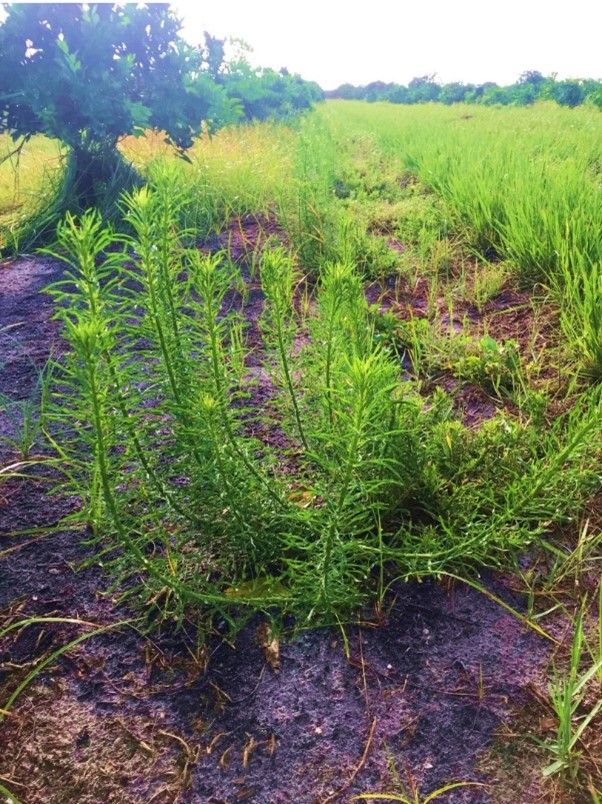
Credit: Ramdas Kanissery, UF/IFAS
This publication presents information about the lifecycle, identification, and management of horseweed (Conyza canadensis) in citrus groves. This publication is mainly intended for Florida citrus growers but will also be helpful for Extension agents, crop consultants, and others interested in citrus production.
Distribution and Life Cycle
Horseweed is a native of North America but naturalized worldwide. It is found in Florida in undisturbed soils, fallow fields, citrus groves, fruit tree orchards, pastures, and roadsides. It can flourish under a wide range of environmental and soil conditions such as pH, fertility, and moisture. Horseweed is a unique species in that it can germinate as soon as environmental conditions are favorable. The seeds do not require dormancy to germinate (Wu et al. 2007).
Horseweed grows throughout the year in Florida as it has the ability to acclimate to different growing conditions. It grows both as a summer annual and winter annual. Seeds may germinate in the spring (summer-annual life cycle) or late summer to early fall (winter-annual life cycle). Horseweed that emerged in late spring will form a rosette (a circular arrangement of leaves that sit near the soil surface) initially and undergo bolting (production of the flowering stem) in a relatively short time. However, seedlings that emerge in fall will form a rosette of hairy leaves, overwinter as a rosette, and undergo bolting in early spring.
Description
Stem: The stem of horseweed is erect and covered with tiny stiff hairs (Figure 2). The main stem is branched out at the top of the plant, where flowers emerge. The plant typically grows in one erect stalk, but several basal branches will develop if the main stem is severed by cutting or mowing. A mature plant can grow up to 1 to 6 feet tall.
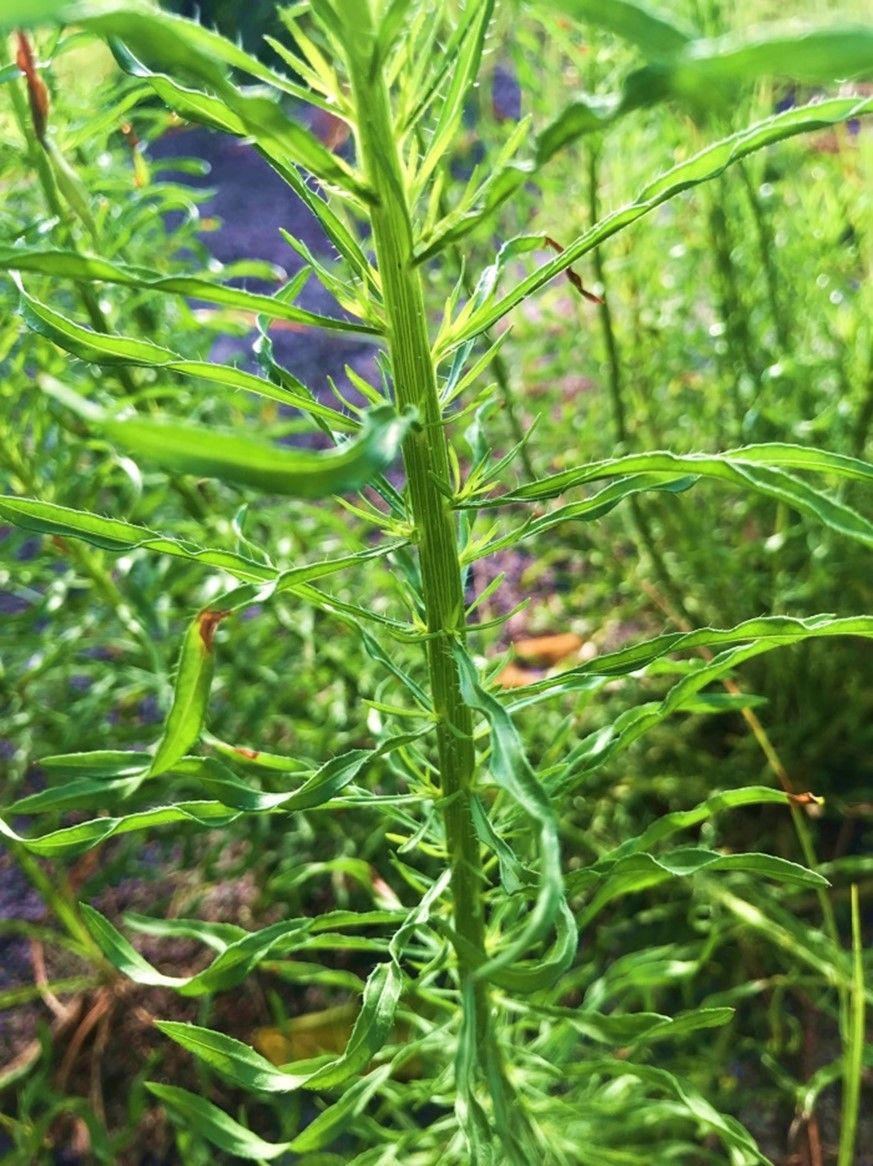
Credit: Ramdas Kanissery, UF/IFAS
Leaves: There are densely arranged green leaves along the entire length of the horseweed stem (Figure 3). Leaves are alternately arranged, oblanceolate to linear-lanceolate shaped, and measuring around 3 to 4 inches in length. Leaves are progressively shorter in length toward the top of the plant. The middle and upper leaves are sessile with a smooth margin, but the lower leaves have short petioles with short bristly hairs along the margins. The crushed leaves have a carrot-like scent.
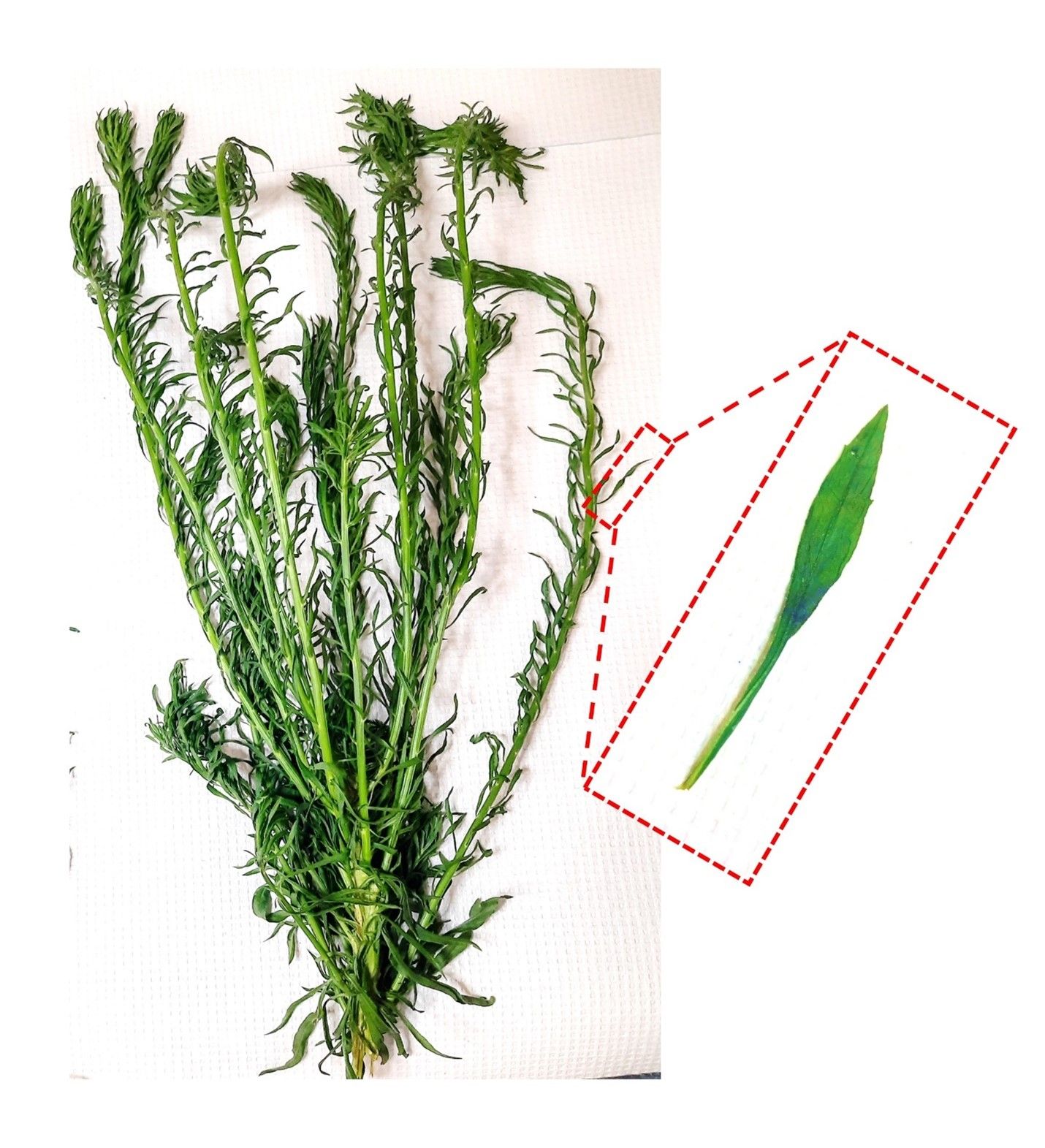
Credit: Nirmal Timilsina, UF/IFAS
Roots: Horseweed has a short taproot; however, it produces several lateral roots with secondary fibrous root systems (Figure 4). Hence, mature horseweed plants are difficult to remove by hand-pulling from the soil.
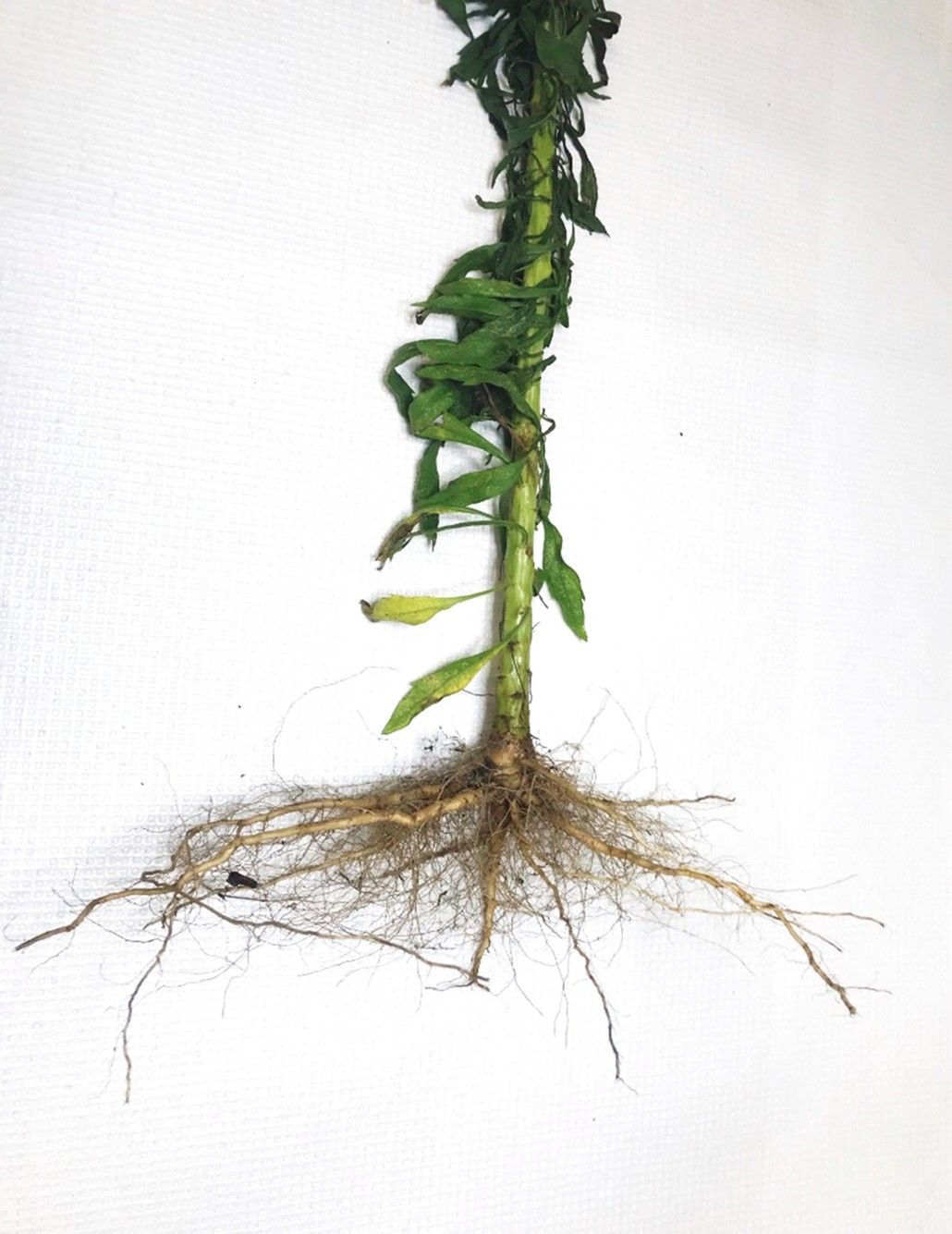
Credit: Ramdas Kanissery, UF/IFAS
Flowers: Many small flowers are formed in racemes on the top of the stem (Figure 5). The common names "marestail" and "coltstail" are based on the flower structures that resemble a broom. The flower has an urn-shaped green base with a small daisy-like flower at the top. The tiny ray and disc florets are white and yellow, respectively. Flowers bloom from June through September and last about 2–3 weeks.
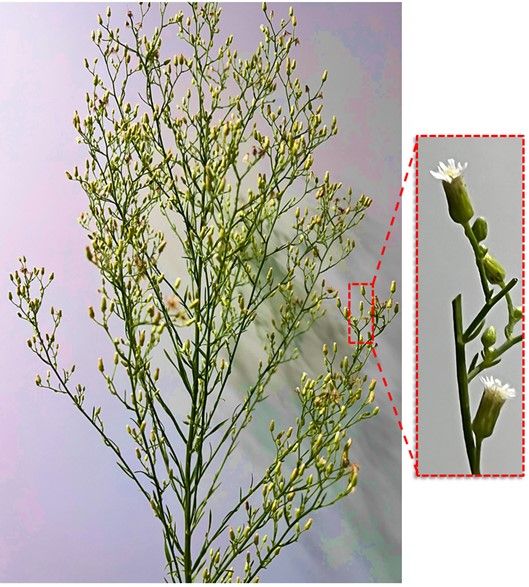
Credit: Nirmal Timilsina, UF/IFAS
Seeds: Horseweed is a prolific seed producer. One horseweed plant can produce an average of 200,000 seeds. Each seed is enclosed inside tiny fruits or seedpods (achenes) that are tan-colored and 1 to 1.5 mm (0.06 inches) long. Wind can quickly disperse these lightweight achenes. These windblown seeds have been found over 500 meters away from where they were shed (Dauer et al. 2007). However, a study by Thebaud et al. (1996) found that seeds stored under dry conditions or laboratory conditions were only viable for a short period (3 years). Seed production corresponds to flowering, typically ranging from late July to October (Shields et al. 2006).
Similar Species
Horseweed is often misidentified as hairy fleabane (Conyza bonariensis). Horseweed and hairy fleabane prefer similar soil types and seed germination conditions. These two species produce similar-looking seed pods. Hairy fleabane can germinate at a lower temperature than horseweed (Karlsson et al. 2007). A distinguishing characteristic at the seedling stage is that horseweed leaves are dull green with short hairs, whereas fleabane leaves are narrower with grayish-green color. Generally, a mature horseweed plant is relatively taller than hairy fleabane.
Economic Significance
Although horseweed is a known weed in several tree crops, including citrus, little documentation on yield losses exists. This weed can potentially impact citrus yield through direct competition for resources: soil nutrients, water, and light (Shrestha et al. 2008). Young citrus with less extensive root systems are more susceptible to competition from horseweeds. Horseweed can also serve as a host for many citrus insects, pathogens, and rodents. It harbors a glassy-winged sharpshooter, a species of leafhoppers that feeds on citrus trees (Wistrom and Purcell 2005). Horseweed is also known to be a habitat for tarnished plant bugs (Lygus lineolaris), a pest known to damage many economically important crops, including vegetables, strawberries, citrus, and peach (Latson et al. 1997).
Management
Integrated management of horseweed in citrus comprises a blend of cultural, mechanical, and chemical weed control tactics that target sensitive growth stages. The key to managing horseweed is to start early when they are small, because young plants are easier to control.
Cultural and Mechanical Control
Horseweed plants can be relatively easily uprooted from the sandy soil of Florida citrus groves. The best way to control minor occurrences is to pull them out before they grow big. Horseweed spreads quickly in croplands that are under no-till situations. Soil disturbance, by cultivation or tillage, during the seedling and rosette stage is an effective method of controlling horseweed (Brown et al. 1988). However, tillage can be counterproductive in citrus groves because it can increase soil erosion and the risk of damaging shallow fibrous citrus roots. Mowing, trimming, or cutting/damaging the shoot from the base will produce multiple stems, resulting in increased plant biomass. Nevertheless, these methods will help prevent seed production and the subsequent soil seed bank formation.
Chemical Control
A list of herbicides that provide horseweed control in citrus is summarized in Table 1. Rotating the applications of herbicides with different modes of action (MOA) may reduce the chance of herbicide tolerance and resistance issues. Glyphosate will control susceptible horseweed, but resistance to glyphosate is widespread across the United States. Tank mixing herbicides from different MOA will help improve their effectiveness in horseweed control. For instance, a combination of glyphosate and saflufenacil effectively controls this weed. Seedling or rosette stage horseweed is more sensitive to herbicide chemicals than mature plants because it tends to form a woody stem at maturity (Shrestha et al. 2008). It is beneficial to apply the postemergent herbicide when plants are young (less than 4 to 6 inches tall). It is also helpful to correspond herbicide application with the active growth of the horseweed plant (fall or early spring).
Preemergent herbicide treatments give the best results when applied in clean soil free of any debris. Therefore, existing weeds and other debris in the tree rows can potentially reduce the efficacy of preemergent herbicides.
Table 1. Herbicides used for horseweed management in citrus. Contact: Ramdas Kanissery (rkanissery@ufl.edu). This table lists registered pesticides that should be integrated with other pest management methods. Contact your local UF/IFAS Extension office for additional information (https://sfyl.ifas.ufl.edu/find-your-local-office/).
References
Brown, S. M., and T. Whitwell. 1988. “Influence of Tillage on Horseweed, Conyza canadensis.” Weed Technology 2 (3): 269–270. https://doi.org/10.1017/S0890037X00030566
Dauer, J. T., D. A. Mortensen, and M. J. Vangessel. 2007. “Temporal and Spatial Dynamics of Long‐Distance Conyza canadensis Seed Dispersal.” Journal of Applied Ecology 44 (1): 105–114. https://doi.org/10.1111/j.1365-2664.2006.01256.x
Karlsson, L. M., and P. Milberg. 2007. “Comparing After‐Ripening Response and Germination Requirements of Conyza canadensis and C. bonariensis (Asteraceae) through Logistic Functions.” Weed Research 47 (5): 433–441. https://doi.org/10.1111/j.1365-3180.2007.00576.x
Latson, L. N., J. N. Jenkins, W. L. Parrott, and F. G. Maxwell. 1977. “Behavior of the Tarnished Plant Bug, Lygus lineolaris, on Cotton, Gossypium hirsutum L., and Horseweed, Erigeron canadensis [the Principal Wild Host Plant].” Technical Bulletin. Mississippi Agricultural and Forestry Experiment Station (USA). no. 85.
Moretti, M. L., L. M. Sosnoskie, A. Shrestha, S. D. Wright, K. J. Hembree, M. Jasieniuk, and B. D. Hanson. 2016. “Distribution of Conyza sp. in Orchards of California and Response to Glyphosate and Paraquat.” Weed Science 64 (2): 339–347. https://doi.org/10.1614/WS-D-15-00174.1
Shields, E. J., J. T. Dauer, M. J. VanGessel, and G. Neumann. 2006. “Horseweed (Conyza canadensis) Seed Collected in the Planetary Boundary Layer.” Weed Science 54 (6): 1063–1067. https://doi.org/10.1614/WS-06-097R1.1
Shrestha, A., K. Hembree, and S. Wright. 2008. “Biology and Management of Horseweed and Hairy Fleabane in California.” University of California, Agriculture and Natural Resources. https://doi.org/10.3733/ucanr.8314
Thebaud, C., A. C. Finzi, L. Affre, M. Debussche, and J. Escarre. 1996. “Assessing Why Two Introduced Conyza Differ in Their Ability to Invade Mediterranean Old Fields.” Ecology 77 (3): 791–804. https://doi.org/10.2307/2265502
Wistrom, C., and A. H. Purcell. 2005. “The Fate of Xylella fastidiosa in Vineyard Weeds and Other Alternate Hosts in California.” Plant Disease 89 (9): 994–999. https://doi.org/10.1094/PD-89-0994
Wu, H., S. Walker, M. J. Rollin, D. K. Y. Tan, G. Robinson, and J. Werth. 2007. “Germination, Persistence, and Emergence of Flaxleaf Fleabane (Conyza bonariensis [L.] Cronquist).” Weed Biology and Management 7 (3): 192–199. https://doi.org/10.1111/j.1445-6664.2007.00256.x